Journal of Southern Medical University ›› 2025, Vol. 45 ›› Issue (8): 1672-1681.doi: 10.12122/j.issn.1673-4254.2025.08.12
Xiao ZHANG1( ), Jingzhou MAN1, Yong ZHANG2, YunJian ZHENG2, Heping WANG1, Yijun YUAN1(
), Jingzhou MAN1, Yong ZHANG2, YunJian ZHENG2, Heping WANG1, Yijun YUAN1( ), Xi XIE1(
), Xi XIE1( )
)
Received:2025-01-21
Online:2025-08-20
Published:2025-09-05
Contact:
Yijun YUAN, Xi XIE
E-mail:740597089@qq.com;yijun.yuan@hainanu.edu.cn;xiexi@hainanu.edu.cn
Xiao ZHANG, Jingzhou MAN, Yong ZHANG, YunJian ZHENG, Heping WANG, Yijun YUAN, Xi XIE. Haematococcus pluvialis alleviates bleomycin-induced pulmonary fibrosis in mice by inhibiting transformation of lung fibroblasts into myofibroblast[J]. Journal of Southern Medical University, 2025, 45(8): 1672-1681.
Add to citation manager EndNote|Ris|BibTeX
URL: https://www.j-smu.com/EN/10.12122/j.issn.1673-4254.2025.08.12
| Primer | Forward primer sequence (5'-3') | Reverse primer sequence (5'-3') |
|---|---|---|
| Mouse Col1 | CTTTGCTTCCCAGATGTCCT | CGGTGTCCCTTCATTCCAG |
| Mouse Col3 | GGCAGTGATGGGCAACCT | TCCCTTCGCACCGTTCTT |
| Mouse α-SMA | GGGAGTAATGGTTGGAATG | CTCAAACATAATCTGGGTCA |
| Mouse FN1 | CATTGTTACCAACTGGGACG | CCAGAGGCATACAGGGAC |
| Mouse Col5 | GGACTCGGCGGAACATTG | GGGAGTTGAGGGAACCAAA |
| Mouse GAPDH | TGTTTCCTCGTCCCGTAG | CAATCTCCACTTTGCCACT |
| Human Col1 | AAGGTGTTGTGCGATGACG | TGGTCGGTGGGTGACTCTG |
| Human Col3 | GAGCTGGCTACTTCTCGC | TCTATCCGCATAGGACTGAC |
| Human α-SMA | GGGGTGATGGTGGGAATG | GCAGGGTGGGATGCTCTT |
| Human FN1 | ATGGAGGAAGCCGAGGTT | AGCGGTTTGCGATGGTAC |
| Human Col5 | TGGCAAGTGGCACAGAATT | TCACCCTCAAACACCTCCTC |
| Human β-actin | GGAAATCGTGCGTGACATT | CAGGCAGCTCGTAGCTCTT |
Tab.1 Primer sequences for qRT-PCR
| Primer | Forward primer sequence (5'-3') | Reverse primer sequence (5'-3') |
|---|---|---|
| Mouse Col1 | CTTTGCTTCCCAGATGTCCT | CGGTGTCCCTTCATTCCAG |
| Mouse Col3 | GGCAGTGATGGGCAACCT | TCCCTTCGCACCGTTCTT |
| Mouse α-SMA | GGGAGTAATGGTTGGAATG | CTCAAACATAATCTGGGTCA |
| Mouse FN1 | CATTGTTACCAACTGGGACG | CCAGAGGCATACAGGGAC |
| Mouse Col5 | GGACTCGGCGGAACATTG | GGGAGTTGAGGGAACCAAA |
| Mouse GAPDH | TGTTTCCTCGTCCCGTAG | CAATCTCCACTTTGCCACT |
| Human Col1 | AAGGTGTTGTGCGATGACG | TGGTCGGTGGGTGACTCTG |
| Human Col3 | GAGCTGGCTACTTCTCGC | TCTATCCGCATAGGACTGAC |
| Human α-SMA | GGGGTGATGGTGGGAATG | GCAGGGTGGGATGCTCTT |
| Human FN1 | ATGGAGGAAGCCGAGGTT | AGCGGTTTGCGATGGTAC |
| Human Col5 | TGGCAAGTGGCACAGAATT | TCACCCTCAAACACCTCCTC |
| Human β-actin | GGAAATCGTGCGTGACATT | CAGGCAGCTCGTAGCTCTT |
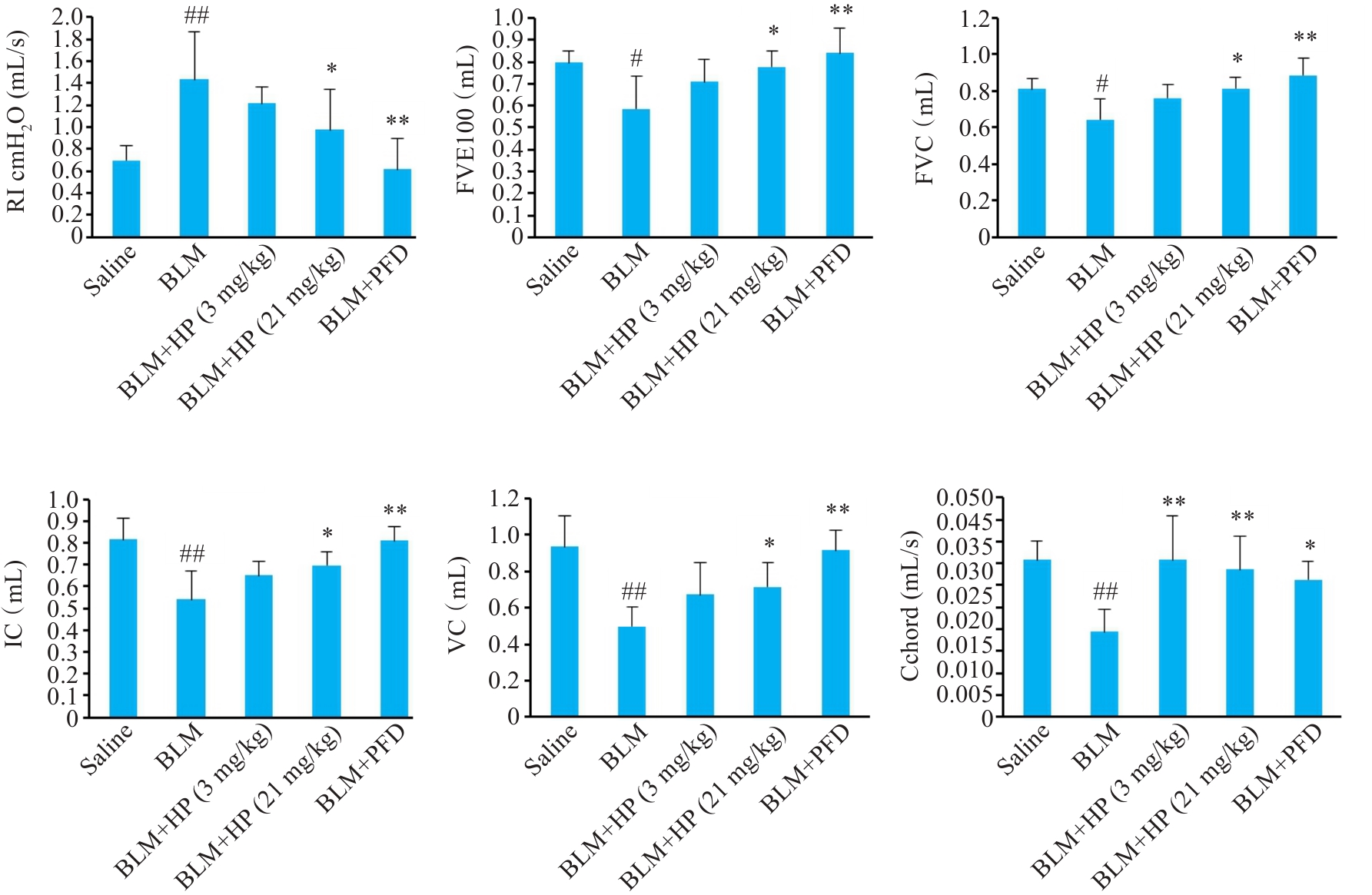
Fig.1 Effect of HP on pulmonary respiratory function in bleomycin-induced mouse pulmonary fibrosis model. Saline: Control group; BLM: Bleomycin-induced model group; BLM+HP (3 mg/kg): Low-dose HP group; BLM+HP (21 mg/kg): High-dose HP group; BLM+PFD: Positive drug pirfenidone control group. #P<0.05, ##P<0.01 vs Saline group; *P<0.05, **P<0.01 vs BLM group.
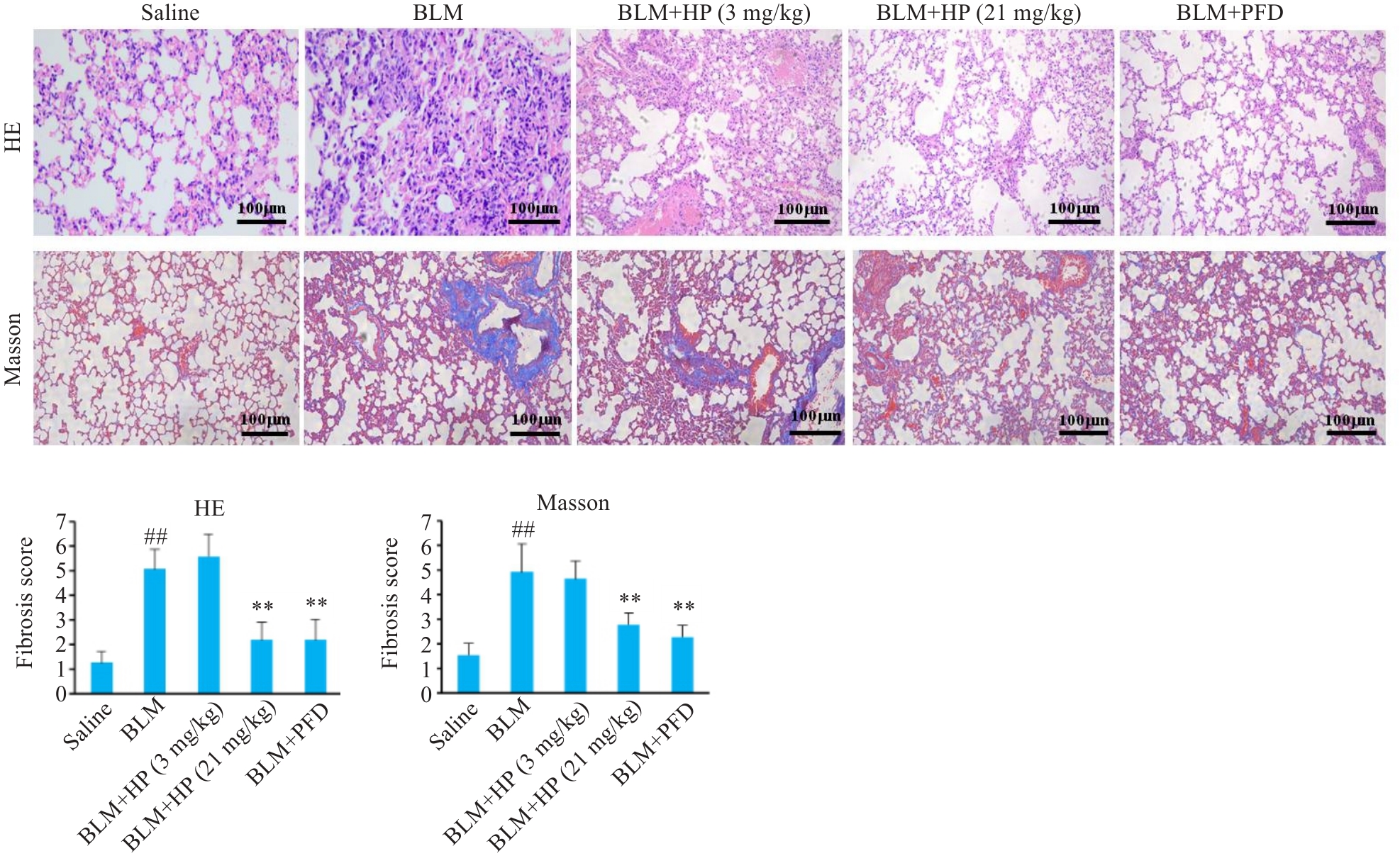
Fig.2 Effects of HP on lung tissue histology and collagen deposition in mice with bleomycin-induced pulmonary fibrosis. ##P<0.01 vs Saline group; **P<0.01 vs BLM group.
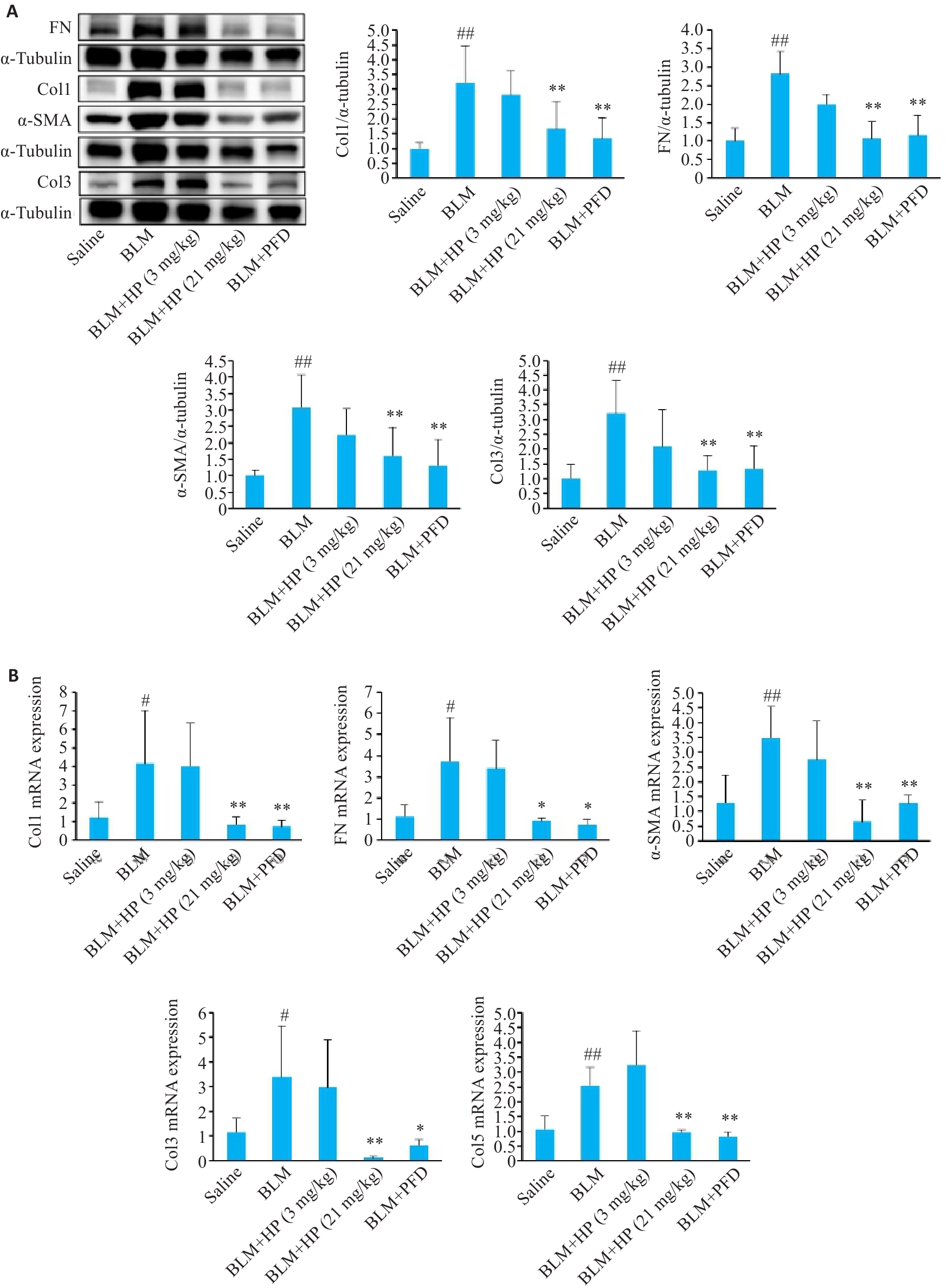
Fig.3 Western blotting (A) and qRT-PCR (B) for assessing the effect of HP on expressions of fibrotic proteins in the lung tissue of mice with bleomycin-induced pulmonary fibrosis. #P<0.05, ##P<0.01 vs saline group; *P<0.05, **P<0.01 vs BLM group.
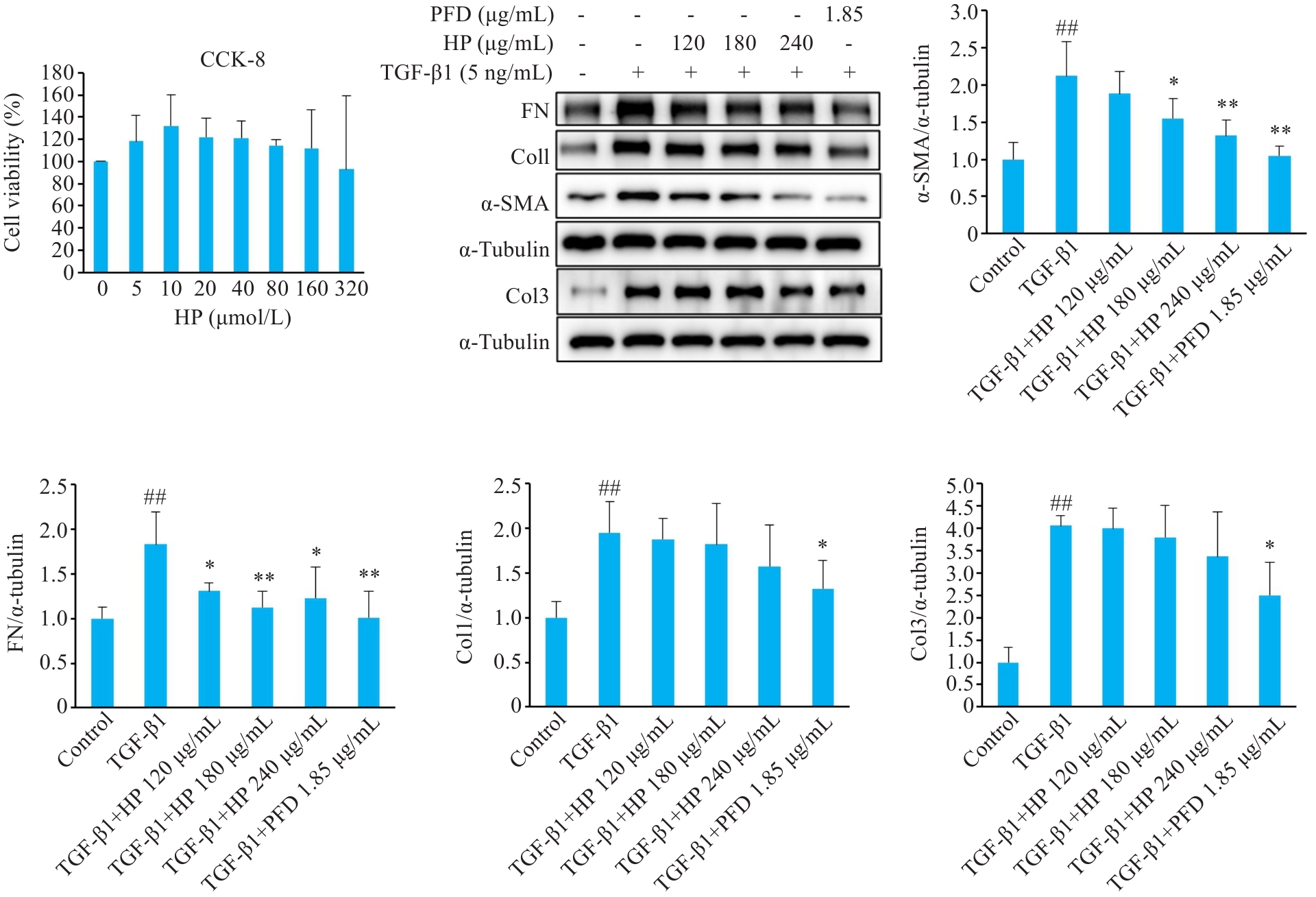
Fig.4 Effect of different concentrations of HP on expression levels of fibrotic proteins in TGF-β1-induced HFL1 cell model. CCK-8 was used for detecting changes in proliferation of HFL1 cells treated with different concentrations of HP. Western blotting was used to detect the expression levels of fibrotic proteins of the treated cells. Except for the control group, all the other groups were induced with 5 ng/mL TGF-β1. ##P<0.01 vs Control group; *P<0.05, **P<0.01 vs TGF-β1 group.

Fig.5 Immunofluorescence (A) and qRT-PCR (B) for detecting the effects of high-dose HP (240 μg/mL) on expression levels of fibrotic proteins in TGF-β1-induced HFL1 cells. Model: TGF-β1-induced cells; HP: Cells treated with 240 μg/mL HP. #P<0.05, ##P<0.01 vs Control group. *P<0.05, **P<0.01 vs Model group.
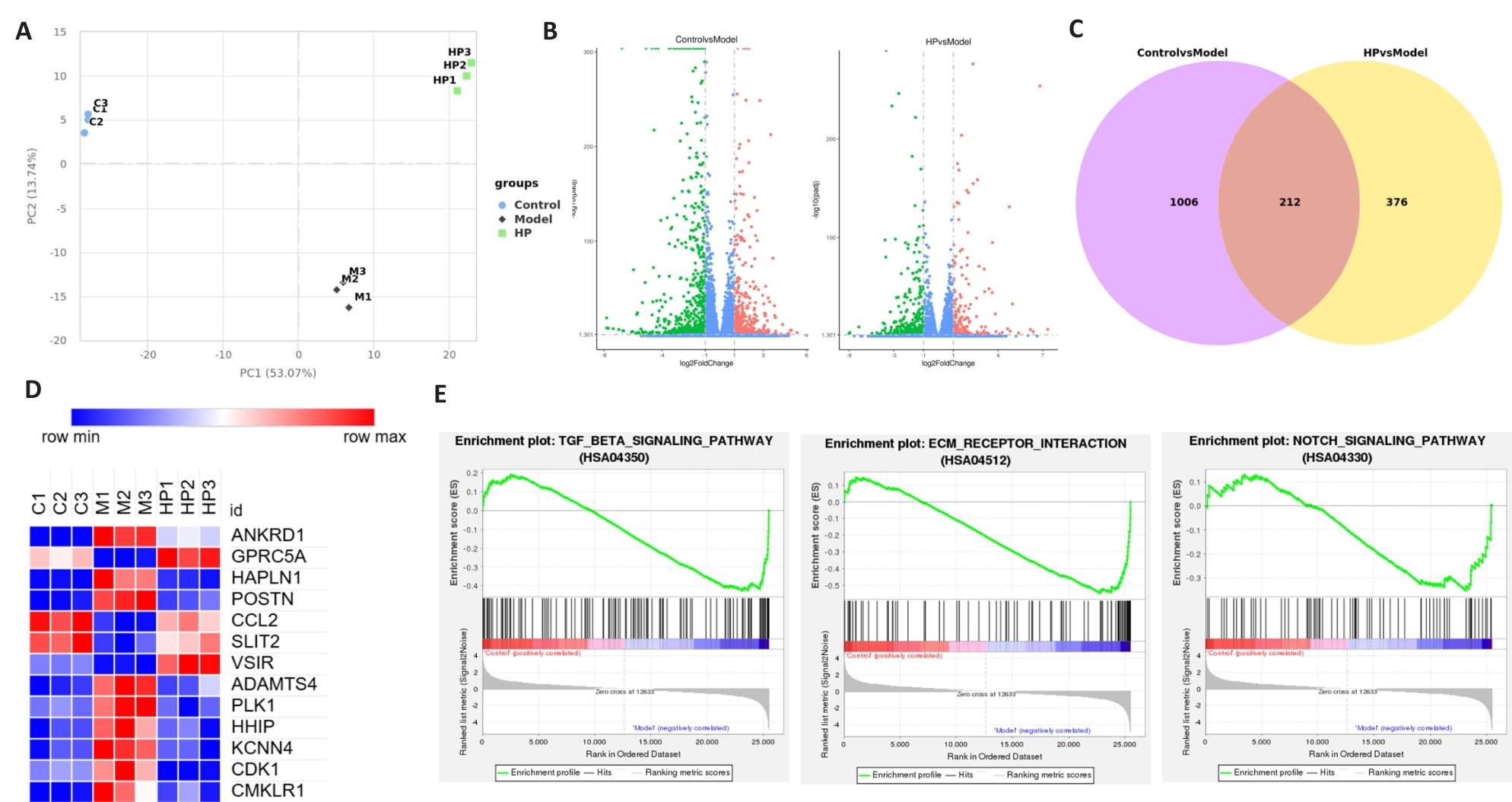
Fig.6 Transcriptome analysis of the effects of high-dose HP (240 μg/mL) on pulmonary fibrosis-associated gene expression levels and major pathways in TGF-β1-induced HFL1 cell models. C1, C2, and C3: Three replicates of control cells; M1, M2, and M3: Three replicates of TGF-β1-induced cells; HP1, HP2, and HP3: Three replicates of cells treated with 240 μg/mL HP. A: PCA analysis. B: DEGs analysis. C: Venny diagram. D: Gene expression. E: Enrichment plot.
| Gene | Full name | Expression in the model | Function |
|---|---|---|---|
| ANKRD1 | Ankyrin repeat domain-containing protein 1 | Upregulation | Pro-fibrosis[ |
| GPRC5A | G protein-coupled receptor class C group 5 member A | Downregulation | Anti-fibrosis[ |
| HAPLN1 | Hyaluronan and proteoglycan link protein 1 | Upregulation | Pro-fibrosis [ |
| POSTN | Periostin | Upregulation | Pro-fibrosis [ |
| CCL2 | C-C motif chemokine 2 | Downregulation | Anti-fibrosis [ |
| SLIT2 | Slit homolog 2 protein | Downregulation | Anti-fibrosis [ |
| VSIR | V-type immunoglobulin domain-containing suppressor of T-cell activation | Downregulation | Anti-fibrosis [ |
| ADAMTS4 | A disintegrin and metalloproteinase with thrombospondin motifs | Upregulation | Pro-fibrosis [ |
| PLK1 | Serine/threonine-protein kinase | Upregulation | Pro-fibrosis [ |
| HHIP | Hedgehog-interacting protein | Upregulation | Pro-fibrosis [ |
| KCNN4 | Intermediate conductance calcium-activated potassium channel protein 4 | Upregulation | Pro-fibrosis [ |
| CDK1 | Cyclin-dependent kinase 1 | Upregulation | Pro-fibrosis [ |
| CMKLR1 | Chemokine-like receptor 1 | Upregulation | Pro-fibrosis [ |
Tab.2 Differentially expressed genes related to fibrosis
| Gene | Full name | Expression in the model | Function |
|---|---|---|---|
| ANKRD1 | Ankyrin repeat domain-containing protein 1 | Upregulation | Pro-fibrosis[ |
| GPRC5A | G protein-coupled receptor class C group 5 member A | Downregulation | Anti-fibrosis[ |
| HAPLN1 | Hyaluronan and proteoglycan link protein 1 | Upregulation | Pro-fibrosis [ |
| POSTN | Periostin | Upregulation | Pro-fibrosis [ |
| CCL2 | C-C motif chemokine 2 | Downregulation | Anti-fibrosis [ |
| SLIT2 | Slit homolog 2 protein | Downregulation | Anti-fibrosis [ |
| VSIR | V-type immunoglobulin domain-containing suppressor of T-cell activation | Downregulation | Anti-fibrosis [ |
| ADAMTS4 | A disintegrin and metalloproteinase with thrombospondin motifs | Upregulation | Pro-fibrosis [ |
| PLK1 | Serine/threonine-protein kinase | Upregulation | Pro-fibrosis [ |
| HHIP | Hedgehog-interacting protein | Upregulation | Pro-fibrosis [ |
| KCNN4 | Intermediate conductance calcium-activated potassium channel protein 4 | Upregulation | Pro-fibrosis [ |
| CDK1 | Cyclin-dependent kinase 1 | Upregulation | Pro-fibrosis [ |
| CMKLR1 | Chemokine-like receptor 1 | Upregulation | Pro-fibrosis [ |
| [1] | Hewlett JC, Kropski JA, Blackwell TS. Idiopathic pulmonary fibrosis: Epithelial-mesenchymal interactions and emerging therapeutic targets[J]. Matrix Biol, 2018, 71: 112-27. doi:10.1016/j.matbio.2018.03.021 |
| [2] | Richeldi L, Collard HR, Jones MG. Idiopathic pulmonary fibrosis[J]. Lancet, 2017, 389(10082): 1941-52. doi:10.1016/s0140-6736(17)30866-8 |
| [3] | Cruwys S, Hein P, Humphries B, et al. Drug discovery and development in idiopathic pulmonary fibrosis: challenges and opportunities[J]. Drug Discov Today, 2020, 25(12): 2277-83. doi:10.1016/j.drudis.2020.09.019 |
| [4] | 丛晓梅, 臧晓南, 王振东, 等. 雨生红球藻虾青素合成关键酶的原核表达及纯化[J]. 海洋湖沼通报, 2022, 44(6): 49-56. doi:10.13984/j.cnki.cn37-1141.2022.06.007 |
| [5] | Lorenz RT, Cysewski GR. Commercial potential for Haematococcus microalgae as a natural source of astaxanthin[J]. Trends Biotechnol, 2000, 18(4): 160-7. doi:10.1016/s0167-7799(00)01433-5 |
| [6] | 李文学, 白慧颖, 赵宏晶, 等. 雨生红球藻虾青素积累条件优化研究[J]. 食品研究与开发, 2021, 42(16): 152-6. doi:10.12161/j.issn.1005-6521.2021.16.022 |
| [7] | Li K, Wang W, Xiao W. Astaxanthin: a promising therapeutic agent for organ fibrosis[J]. Pharmacol Res, 2023, 188: 106657. doi:10.1016/j.phrs.2023.106657 |
| [8] | Cheng J, Eroglu A. The promising effects of astaxanthin on lung diseases[J]. Adv Nutr, 2021, 12(3): 850-64. doi:10.1093/advances/nmaa143 |
| [9] | 王裕玉, 宋庆辉, 贾 晶, 等. 雨生红球藻的营养价值及其在鱼类饲料中的应用[J]. 饲料研究, 2023, 46(17): 167-72. doi:10.13557/j.cnki.issn1002-2813.2023.17.033 |
| [10] | Zhao J, Meng M, Zhang J, et al. Astaxanthin ameliorates renal interstitial fibrosis and peritubular capillary rarefaction in unilateral ureteral obstruction[J]. Mol Med Rep, 2019, 19(4): 3168-78. doi:10.3892/mmr.2019.9970 |
| [11] | Ma HT, Chen SH, Xiong HY, et al. Astaxanthin from Haematococcus pluvialis ameliorates the chemotherapeutic drug (doxorubicin) induced liver injury through the Keap1/Nrf2/HO-1 pathway in mice[J]. Food Funct, 2020, 11(5): 4659-71. doi:10.1039/c9fo02429h |
| [12] | Sarker M, Chowdhury N, Bristy AT, et al. Astaxanthin protects fludrocortisone acetate-induced cardiac injury by attenuating oxidative stress, fibrosis, and inflammation through TGF-β/Smad signaling pathway[J]. Biomed Pharmacother, 2024, 181: 117703. doi:10.1016/j.biopha.2024.117703 |
| [13] | 权博文, 吴 桐, 刘 庆, 等. 蒙古扁桃种仁不同极性部位对博来霉素致大鼠肺纤维化的保护作用[J]. 食品工业科技, 2020, 41(22): 305-9. doi:10.13386/j.issn1002-0306.2020050143 |
| [14] | Zhang J, Xu P, Wang Y, et al. Astaxanthin prevents pulmonary fibrosis by promoting myofibroblast apoptosis dependent on Drp1-mediated mitochondrial fission[J]. J Cell Mol Med, 2015, 19(9): 2215-31. doi:10.1111/jcmm.12609 |
| [15] | Wang MR, Zhang JJ, Song XD, et al. Astaxanthin ameliorates lung fibrosis in vivo and in vitro by preventing transdifferentiation, inhibiting proliferation, and promoting apoptosis of activated cells[J]. Food Chem Toxicol, 2013, 56: 450-8. doi:10.1016/j.fct.2013.03.004 |
| [16] | Song X, Wang B, Lin S, et al. Astaxanthin inhibits apoptosis in alveolar epithelial cells type II in vivo and in vitro through the ROS-dependent mitochondrial signalling pathway[J]. J Cell Mol Med, 2014, 18(11): 2198-212. doi:10.1111/jcmm.12347 |
| [17] | Mazzeo L, Ghosh S, Di Cicco E, et al. ANKRD1 is a mesenchymal-specific driver of cancer-associated fibroblast activation bridging androgen receptor loss to AP-1 activation[J]. Nat Commun, 2024, 15(1): 1038. doi:10.1038/s41467-024-45308-w |
| [18] | Huang ZL, Wang SQ, Liu YT, et al. GPRC5A reduction contributes to pollutant benzo [a] Pyrene injury via aggravating murine fibrosis, leading to poor prognosis of IIP patients[J]. Sci Total Environ, 2020, 739: 139923. doi:10.1016/j.scitotenv.2020.139923 |
| [19] | Evanko SP, Gooden MD, Kang I, et al. A role for HAPLN1 during phenotypic modulation of human lung fibroblasts in vitro [J]. J Histochem Cytochem, 2020, 68(11): 797-811. doi:10.1369/0022155420966663 |
| [20] | Wu S, Liu M, Zhang M, et al. The gene expression of CALD1 CDH2 and POSTN in fibroblast are related to idiopathic pulmonary fibrosis[J]. Front Immunol, 2024, 15: 1275064. doi:10.3389/fimmu.2024.1275064 |
| [21] | Kalderén C, Stadler C, Forsgren M, et al. CCL2 mediates anti-fibrotic effects in human fibroblasts independently of CCR2[J]. Int Immunopharmacol, 2014, 20(1): 66-73. doi:10.1016/j.intimp.2014.02.020 |
| [22] | He CY, Gu L, Li AM, et al. Recombinant Slit2 attenuates tracheal fibroblast activation in benign central airway obstruction by inhibiting the TGF-β1/Smad3 signaling pathway[J]. Mol Cell Probes, 2024, 73: 101947. doi:10.1016/j.mcp.2023.101947 |
| [23] | Kim MG, Yun D, Kang CL, et al. Kidney VISTA prevents IFN-γ/IL-9 axis-mediated tubulointerstitial fibrosis after acute glomerular injury[J]. J Clin Investig, 2022, 132(1): e151189. doi:10.1172/JCI151189 |
| [24] | Boyd DF, Allen EK, Randolph AG, et al. Exuberant fibroblast activity compromises lung function via ADAMTS4[J]. Nature, 2020, 587(7834): 466-71. doi:10.1038/s41586-020-2877-5 |
| [25] | Maria V, Murugan E P, Athiramol S, et al. Inhibition of the extracellular enzyme ADAMTS4 prevents cardiac fibrosis and dysfunction[J]. Cardiovascular Res, 2023, 119(10): 1915-27. |
| [26] | Chen Y, Chen X, Ji YR, et al. PLK1 regulates hepatic stellate cell activation and liver fibrosis through Wnt/β-catenin signalling pathway[J]. J Cell Mol Med, 2020, 24(13): 7405-16. doi:10.1111/jcmm.15356 |
| [27] | Du Y, Shang Y, Qian Y, et al. Plk1 promotes renal tubulointerstitial fibrosis by targeting autophagy/lysosome axis[J]. Cell Death Dis, 2023, 14(8): 571. doi:10.1038/s41419-023-06093-4 |
| [28] | Zhao XP, Chang SY, Liao MC, et al. Hedgehog interacting protein promotes fibrosis and apoptosis in glomerular endothelial cells in murine diabetes[J]. Sci Rep, 2018, 8(1): 5958. doi:10.1038/s41598-018-24220-6 |
| [29] | Mann C, Kaistha BP, Kacik M, et al. Downregulation of miR-503 in activated kidney fibroblasts disinhibits KCNN4 in an in vitro model of kidney fibrosis[J]. Kidney Blood Press Res, 2019, 44(1): 113-22. doi:10.1159/000498875 |
| [30] | Yang L, Han B, Zhang M, et al. Activation of BK channels prevents hepatic stellate cell activation and liver fibrosis through the suppression of TGFβ1/SMAD3 and JAK/STAT3 profibrotic signaling pathways[J]. Front Pharmacol, 2020, 11: 165. doi:10.3389/fphar.2020.00165 |
| [31] | Sai C, Yunhan J, Zhao J, et al. Cyclin dependent kinase 1 (CDK1) activates cardiac fibroblasts via directly phosphorylating paxillin at Ser244[J]. Int Heart J, 2019, 60(2): 374-83. doi:10.1536/ihj.18-073 |
| [32] | Yamamoto T, Matsushima S, Okabe K, et al. Cyclin dependent kinase 1 (CDK1) positively regulates cardiac hypertrophy and fibrosis via TGF-beta pathway[J]. Eur Heart J, 2020, 41(): ehaa946.3743. doi:10.1093/ehjci/ehaa946.3743 |
| [33] | Cai R, Cao R, Liu Y, et al. Chemerin promotes proliferation of cardiac fibroblasts via CMKLR1/PI3k/Akt/NF‑κB signaling pathway[DB/OL]. 2024-04-01. . doi:10.21203/rs.3.rs-4142000/v1 |
| [34] | Mannes PZ, Adams TS, Farsijani S, et al. Noninvasive assessment of the lung inflammation-fibrosis axis by targeted imaging of CMKLR1[J]. Sci Adv, 2024, 10(25): 9817. doi:10.1126/sciadv.adm9817 |
| [35] | 唐海南, 柏 月, 许金震, 等. 雨生红球藻粉对斑节对虾肝胰腺免疫性能及甲醛胁迫下相关基因表达的影响[J]. 厦门大学学报(自然科学版), 2024, 64(8): 1-11. |
| [36] | Zhang T, He X, Caldwell L, et al. NUAK1 promotes organ fibrosis via YAP and TGF-β/SMAD signaling[J]. Sci Transl Med, 2022, 14(637): eaaz4028. doi:10.1126/scitranslmed.aaz4028 |
| [37] | Yan Z, Kui Z, Ping Z. Reviews and prospectives of signaling pathway analysis in idiopathic pulmonary fibrosis[J]. Autoimmun Rev, 2014, 13(10): 1020-5. doi:10.1016/j.autrev.2014.08.028 |
| [38] | Suri GS, Kaur G, Jha CK, et al. Understanding idiopathic pulmonary fibrosis-Clinical features, molecular mechanism and therapies[J]. Exp Gerontol, 2021, 153: 111473. doi:10.1016/j.exger.2021.111473 |
| [39] | 李斯宇, 庞立健, 吕晓东, 等. 特发性肺纤维化复杂网络发病机制与络病理论[J]. 中华中医药杂志, 2022, 37(2): 640-5. |
| [1] | Guoyong LI, Renling LI, Yiting LIU, Hongxia KE, Jing LI, Xinhua WANG. Therapeutic mechanism of Arctium lappa extract for post-viral pneumonia pulmonary fibrosis: a metabolomics, network pharmacology analysis and experimental verification [J]. Journal of Southern Medical University, 2025, 45(6): 1185-1199. |
| [2] | Zhenjia DAI, Qunwei GAO, Mengjiao YING, Ao WANG, Juan HONG, Chunjing WANG, Yu GUO, Changqing LIU, Gaofeng LIU. C6TSEDRVAJZ, a combination of small-molecule compounds, induces differentiation of human placental fibroblasts into epithelioid cells in vitro [J]. Journal of Southern Medical University, 2025, 45(2): 322-330. |
| [3] | Zhoufang CAO, Yuan WANG, Mengna WANG, Yue SUN, Feifei LIU. LINC00837/miR-671-5p/SERPINE2 functional axis promotes pathological processes of fibroblast-like synovial cells in rheumatoid arthritis [J]. Journal of Southern Medical University, 2025, 45(2): 371-378. |
| [4] | Junping ZHAN, Shuo HUANG, Qingliang MENG, Wei FAN, Huimin GU, Jiakang CUI, Huilian WANG. Buyang Huanwu Decoction reduces mitochondrial autophagy in rheumatoid arthritis synovial fibroblasts in hypoxic culture by inhibiting the BNIP3-PI3K/Akt pathway [J]. Journal of Southern Medical University, 2025, 45(1): 35-42. |
| [5] | Jinguang LUO, Huaixiang TAO, Zhiyuan WEN, Long CHEN, Hao HU, Han GUAN. Tumor-associated fibroblasts promotes proliferation and migration of prostate cancer cells by suppressing FBXL3 via upregulating hsa-miR-18b-5p [J]. Journal of Southern Medical University, 2024, 44(7): 1284-1296. |
| [6] | HE Cheng, CHEN Wei, ZHANG Nianzhi, LUAN Jun, WANG Sanfeng, ZHANG You. Shenqi Chongcao Formula ameliorates inflammatory response in rats with pulmonary fibrosis by activating the ASS1/src/STAT3 signaling pathway [J]. Journal of Southern Medical University, 2024, 44(4): 644-651. |
| [7] | WANG Zining, YANG Ming, LI Shuanglei, CHI Haitao, WANG Junhui, XIAO Cangsong. A transcriptomic analysis of correlation between mitochondrial function and energy metabolism remodeling in mice with myocardial fibrosis following myocardial infarction [J]. Journal of Southern Medical University, 2024, 44(4): 666-674. |
| [8] | SHAO Shan, BAI Weichao, ZHOU Pengcheng, LUO Minna, ZHAO Xinhan, LEI Jianjun. Metformin suppresses hypoxia-inducible factor-1α expression in cancer-associated fibroblasts to block tumor-stromal cross-talk in breast cancer [J]. Journal of Southern Medical University, 2024, 44(3): 428-436. |
| [9] | Duanyi SONG, Yun LI, Xuefang TANG, Hua LI, Kang TAO. Diazepam alleviates pulmonary fibrosis in mice by inhibiting LPS-induced pyroptosis and inflammation via the let-7a-5p/MYD88 axis [J]. Journal of Southern Medical University, 2024, 44(11): 2092-2101. |
| [10] | Xueyan XI, Ting DENG, Boyu DU. Colorectal fibroblasts promote malignant phenotype of colorectal cancer cells by activating the ERK signaling pathway [J]. Journal of Southern Medical University, 2024, 44(10): 1866-1873. |
| [11] | Ping SHU, Mengke YUAN, Ke YANG, Weizhi HE, Li LIU. Quercetin suppresses pyroptosis in mouse fibroblasts by inhibiting the NLRP3/caspase-1/GSDMD pathway [J]. Journal of Southern Medical University, 2024, 44(10): 1874-1880. |
| [12] | LIANG Zichen, YU Changhui, LIANG Shixiu, ZHOU Zicong, ZHOU Zili, MENG Xiaojing, ZOU Fei, CAI Shaoxi. Platycodin D improves pulmonary fibrosis in mice by down-regulating TRPC6 expression and reducing ROS production in lung fibroblasts [J]. Journal of Southern Medical University, 2024, 44(1): 60-69. |
| [13] | DENG Ting, DU Boyu, XI Xueyan. Colorectal cancer cells induce the formation of cancer-associated fibroblasts by activating the ERK signaling pathway in fibroblasts [J]. Journal of Southern Medical University, 2023, 43(6): 943-951. |
| [14] | ZONG Shiye, ZHOU Jing, CAI Weiwei, YU Yun, WANG Ying, SONG Yining, CHENG Jingwen, LI Yuhui, GAO Yi, WU Baihai, XIAN Hao, WEI Fang. Berberine inhibits autophagy and promotes apoptosis of fibroblast-like synovial cells from rheumatoid arthritis patients through the ROS/mTOR signaling pathway [J]. Journal of Southern Medical University, 2023, 43(4): 552-559. |
| [15] | YANG Pan, WANG Yuanyuan, GAO Qunwei, LIU Yang, WANG Yi, GUO Yu, LIU Changqing, LIU Gaofeng. Chemical reprogramming of human embryonic fibroblasts into neural progenitor cells in vitro [J]. Journal of Southern Medical University, 2023, 43(3): 360-367. |
| Viewed | ||||||
|
Full text |
|
|||||
|
Abstract |
|
|||||